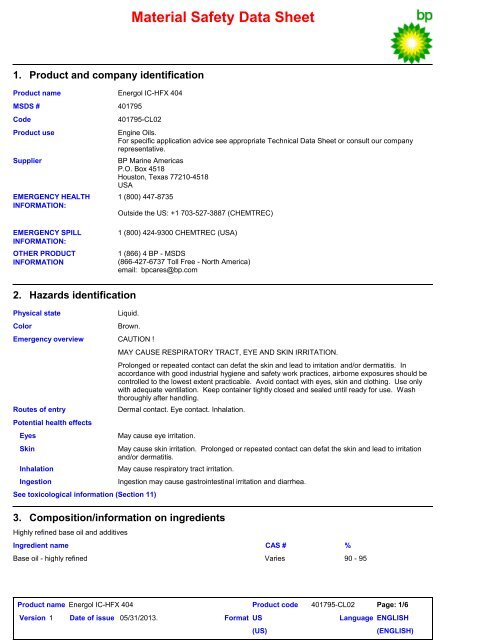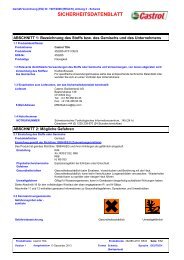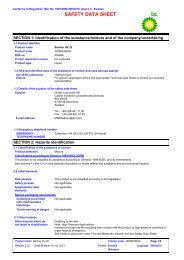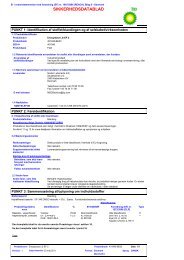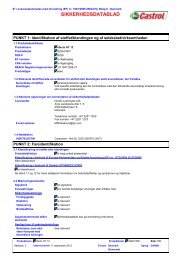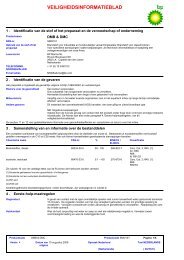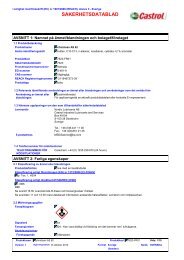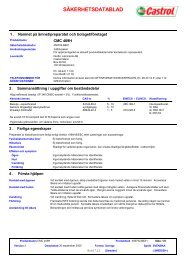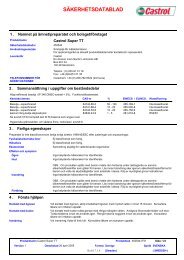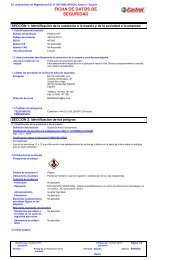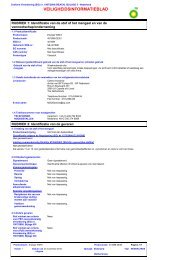Energol IC-HFX 404 - BP - PDS & MSDS Search
Energol IC-HFX 404 - BP - PDS & MSDS Search
Energol IC-HFX 404 - BP - PDS & MSDS Search
You also want an ePaper? Increase the reach of your titles
YUMPU automatically turns print PDFs into web optimized ePapers that Google loves.
1. Product and company identification<br />
Product name <strong>Energol</strong> <strong>IC</strong>-<strong>HFX</strong> <strong>404</strong><br />
<strong>MSDS</strong> # 401795<br />
Code 401795-CL02<br />
Material Safety Data Sheet<br />
Product use Engine Oils.<br />
For specific application advice see appropriate Technical Data Sheet or consult our company<br />
representative.<br />
Supplier <strong>BP</strong> Marine Americas<br />
P.O. Box 4518<br />
Houston, Texas 77210-4518<br />
USA<br />
EMERGENCY HEALTH<br />
INFORMATION:<br />
EMERGENCY SPILL<br />
INFORMATION:<br />
OTHER PRODUCT<br />
INFORMATION<br />
2. Hazards identification<br />
Physical state<br />
Color Brown.<br />
1 (800) 447-8735<br />
Emergency overview CAUTION !<br />
Routes of entry<br />
Potential health effects<br />
Outside the US: +1 703-527-3887 (CHEMTREC)<br />
1 (800) 424-9300 CHEMTREC (USA)<br />
1 (866) 4 <strong>BP</strong> - <strong>MSDS</strong><br />
(866-427-6737 Toll Free - North America)<br />
email: bpcares@bp.com<br />
Liquid.<br />
MAY CAUSE RESPIRATORY TRACT, EYE AND SKIN IRRITATION.<br />
Prolonged or repeated contact can defat the skin and lead to irritation and/or dermatitis. In<br />
accordance with good industrial hygiene and safety work practices, airborne exposures should be<br />
controlled to the lowest extent practicable. Avoid contact with eyes, skin and clothing. Use only<br />
with adequate ventilation. Keep container tightly closed and sealed until ready for use. Wash<br />
thoroughly after handling.<br />
Dermal contact. Eye contact. Inhalation.<br />
Eyes May cause eye irritation.<br />
Skin May cause skin irritation. Prolonged or repeated contact can defat the skin and lead to irritation<br />
and/or dermatitis.<br />
Inhalation May cause respiratory tract irritation.<br />
Ingestion Ingestion may cause gastrointestinal irritation and diarrhea.<br />
See toxicological information (Section 11)<br />
3. Composition/information on ingredients<br />
Highly refined base oil and additives<br />
Ingredient name CAS # %<br />
Base oil - highly refined Varies 90 - 95<br />
Product name <strong>Energol</strong> <strong>IC</strong>-<strong>HFX</strong> <strong>404</strong><br />
Product code<br />
Page: 1/6<br />
Version 1 Date of issue 05/31/2013.<br />
Format US<br />
Language ENGLISH<br />
(US)<br />
401795-CL02<br />
(ENGLISH)
4. First aid measures<br />
Eye contact In case of contact, immediately flush eyes with plenty of water for at least 15 minutes. Get<br />
medical attention if symptoms occur.<br />
Skin contact Immediately wash exposed skin with soap and water. Remove contaminated clothing and shoes.<br />
Wash clothing before reuse. Clean shoes thoroughly before reuse. Get medical attention if<br />
symptoms occur.<br />
Inhalation If inhaled, remove to fresh air. Get medical attention if symptoms occur.<br />
Ingestion Do not induce vomiting unless directed to do so by medical personnel. Never give anything by<br />
mouth to an unconscious person. If potentially dangerous quantities of this material have been<br />
swallowed, call a physician immediately. Get medical attention if symptoms occur.<br />
5. Fire-fighting measures<br />
Flash point Closed cup: 215°C (419°F) [Pensky-Martens.]<br />
Fire/explosion hazards<br />
Extinguishing media<br />
Fire-fighting procedures<br />
Hazardous combustion<br />
products<br />
In a fire or if heated, a pressure increase will occur and the container may burst.<br />
Suitable Use an extinguishing agent suitable for the surrounding fire.<br />
Not suitable<br />
Do not use water jet.<br />
Promptly isolate the scene by removing all persons from the vicinity of the incident if there is a fire.<br />
No action shall be taken involving any personal risk or without suitable training.<br />
Combustion products may include the following:<br />
metal oxide/oxides<br />
carbon oxides (CO, CO2) (carbon monoxide, carbon dioxide)<br />
sulfur oxides (SO, SO2 etc.)<br />
Protective clothing (fire) Fire-fighters should wear appropriate protective equipment and self-contained breathing<br />
apparatus (SCBA) with a full face-piece operated in positive pressure mode.<br />
6. Accidental release measures<br />
Personal precautions<br />
Environmental<br />
precautions<br />
Methods for cleaning up<br />
Large spill<br />
Small spill<br />
7. Handling and storage<br />
No action shall be taken involving any personal risk or without suitable training. Keep<br />
unnecessary and unprotected personnel from entering. Do not touch or walk through spilled<br />
material. In accordance with good industrial hygiene and safety work practices, airborne<br />
exposures should be controlled to the lowest extent practicable. Provide adequate ventilation.<br />
Wear appropriate respirator when ventilation is inadequate. Put on appropriate personal<br />
protective equipment (see Section 8).<br />
Avoid dispersal of spilled material and runoff and contact with soil, waterways, drains and sewers.<br />
Inform the relevant authorities if the product has caused environmental pollution (sewers,<br />
waterways, soil or air).<br />
Stop leak if without risk. Move containers from spill area. Approach release from upwind.<br />
Prevent entry into sewers, water courses, basements or confined areas. Wash spillages into an<br />
effluent treatment plant or proceed as follows. Contain and collect spillage with non-combustible,<br />
absorbent material e.g. sand, earth, vermiculite or diatomaceous earth and place in container for<br />
disposal according to local regulations (see Section 13). Dispose of via a licensed waste disposal<br />
contractor. Contaminated absorbent material may pose the same hazard as the spilled product.<br />
Note: see Section 1 for emergency contact information and Section 13 for waste disposal.<br />
Stop leak if without risk. Move containers from spill area. Dilute with water and mop up if watersoluble.<br />
Alternatively, or if water-insoluble, absorb with an inert dry material and place in an<br />
appropriate waste disposal container. Dispose of via a licensed waste disposal contractor.<br />
Handling Put on appropriate personal protective equipment (see Section 8). Workers should wash hands<br />
and face before eating, drinking and smoking. Do not breathe vapor or mist. Do not ingest.<br />
Avoid contact with eyes, skin and clothing. Use only with adequate ventilation. Wear appropriate<br />
respirator when ventilation is inadequate.<br />
Product name <strong>Energol</strong> <strong>IC</strong>-<strong>HFX</strong> <strong>404</strong><br />
Product code<br />
Page: 2/6<br />
Version 1 Date of issue 05/31/2013.<br />
Format US<br />
Language ENGLISH<br />
(US)<br />
401795-CL02<br />
(ENGLISH)
Storage Store in accordance with local regulations. Store away from direct sunlight in a dry, cool and wellventilated<br />
area, away from incompatible materials (see Section 10). Keep container tightly closed<br />
and sealed until ready for use. Containers that have been opened must be carefully resealed and<br />
kept upright to prevent leakage. Do not store in unlabeled containers. Use appropriate<br />
containment to avoid environmental contamination.<br />
Not suitable Prolonged exposure to elevated temperature<br />
8. Exposure controls/personal protection<br />
Occupational exposure limits<br />
Ingredient name Occupational exposure limits<br />
Base oil - highly refined ACGIH TLV (United States).<br />
TWA: 5 mg/m³ 8 hours. Issued/Revised: 11/2009 Form: Inhalable fraction<br />
NIOSH REL (United States).<br />
TWA: 5 mg/m³ 10 hours. Issued/Revised: 6/1994 Form: Mist<br />
STEL: 10 mg/m³ 15 minutes. Issued/Revised: 6/1994 Form: Mist<br />
OSHA PEL (United States).<br />
TWA: 5 mg/m³ 8 hours. Issued/Revised: 6/1993<br />
While specific OELs for certain components may be shown in this section, other components may be present in any mist, vapor or<br />
dust produced. Therefore, the specific OELs may not be applicable to the product as a whole and are provided for guidance only.<br />
Some states may enforce more stringent exposure limits.<br />
Control Measures Use only with adequate ventilation. If user operations generate dust, fumes, gas, vapor or mist,<br />
use process enclosures, local exhaust ventilation or other engineering controls to keep worker<br />
exposure to airborne contaminants below any recommended or statutory limits.<br />
Hygiene measures Wash hands, forearms and face thoroughly after handling chemical products, before eating,<br />
smoking and using the lavatory and at the end of the working period. Appropriate techniques<br />
should be used to remove potentially contaminated clothing. Wash contaminated clothing before<br />
reusing.<br />
Personal protection<br />
9.<br />
Eyes Avoid contact with eyes. Safety glasses with side shields or chemical goggles.<br />
Skin and body Avoid contact with skin and clothing. Wear suitable protective clothing.<br />
Respiratory Use adequate ventilation. In accordance with good industrial hygiene and safety work practices,<br />
airborne exposures should be controlled to the lowest extent practicable.<br />
Hands The correct choice of protective gloves depends upon the chemicals being handled, the conditions<br />
of work and use, and the condition of the gloves (even the best chemically resistant glove will<br />
break down after repeated chemical exposures). Most gloves provide only a short time of<br />
protection before they must be discarded and replaced. Because specific work environments and<br />
material handling practices vary, safety procedures should be developed for each intended<br />
application. Gloves should therefore be chosen in consultation with the supplier/manufacturer and<br />
with a full assessment of the working conditions.<br />
Physical and chemical properties<br />
Physical state Liquid.<br />
Color Brown.<br />
Density<br />
Consult your supervisor or Standard Operating Procedure (S.O.P) for special handling instructions.<br />
Flash point Closed cup: 215°C (419°F) [Pensky-Martens.]<br />
913 kg/m³ (0.913 g/cm³) at 15°C<br />
Viscosity Kinematic: 133 mm 2 /s (133 cSt) at 40°C<br />
Kinematic: 13.5 to 14.5 mm 2 /s (13.5 to 14.5 cSt) at 100°C<br />
Solubility insoluble in water.<br />
Product name <strong>Energol</strong> <strong>IC</strong>-<strong>HFX</strong> <strong>404</strong><br />
Product code<br />
Page: 3/6<br />
Version 1 Date of issue 05/31/2013.<br />
Format US<br />
Language ENGLISH<br />
(US)<br />
401795-CL02<br />
(ENGLISH)
10. Stability and reactivity<br />
Stability and reactivity<br />
Possibility of hazardous<br />
reactions<br />
Conditions to avoid<br />
Incompatibility with<br />
various substances<br />
Hazardous decomposition<br />
products<br />
Hazardous polymerization<br />
The product is stable.<br />
11. Toxicological information<br />
Other Toxicity Data<br />
Potential chronic health effects<br />
Under normal conditions of storage and use, hazardous reactions will not occur.<br />
Avoid all possible sources of ignition (spark or flame).<br />
Reactive or incompatible with the following materials: oxidizing materials.<br />
Under normal conditions of storage and use, hazardous decomposition products should not be<br />
produced.<br />
Under normal conditions of storage and use, hazardous polymerization will not occur.<br />
USED ENGINE OILS<br />
Combustion products resulting from the operation of internal combustion engines contaminate<br />
engine oils during use. Used engine oil may contain hazardous components which have the<br />
potential to cause skin cancer. Frequent or prolonged contact with all types and makes of used<br />
engine oil must therefore be avoided and a high standard of personal hygiene maintained.<br />
Carcinogenicity No known significant effects or critical hazards.<br />
12. Ecological information<br />
Ecotoxicity<br />
No testing has been performed by the manufacturer.<br />
Persistence/degradability Expected to be biodegradable.<br />
13. Disposal considerations<br />
Waste information The generation of waste should be avoided or minimized wherever possible. Disposal of this<br />
product, solutions and any by-products should at all times comply with the requirements of<br />
environmental protection and waste disposal legislation and any regional local authority<br />
requirements. Dispose of surplus and non-recyclable products via a licensed waste disposal<br />
contractor. Waste should not be disposed of untreated to the sewer unless fully compliant with<br />
the requirements of all authorities with jurisdiction. Waste packaging should be recycled.<br />
Incineration or landfill should only be considered when recycling is not feasible. This material and<br />
its container must be disposed of in a safe way. Care should be taken when handling emptied<br />
containers that have not been cleaned or rinsed out. Empty containers or liners may retain some<br />
product residues. Avoid dispersal of spilled material and runoff and contact with soil, waterways,<br />
drains and sewers.<br />
NOTE: The generator of waste has the responsibility for proper waste identification (based on characteristic(s) or listing),<br />
transportation and disposal<br />
14. Transport information<br />
Not classified as hazardous for transport (DOT, TDG, IMO/IMDG, IATA/<strong>IC</strong>AO)<br />
Product name <strong>Energol</strong> <strong>IC</strong>-<strong>HFX</strong> <strong>404</strong><br />
Product code<br />
Page: 4/6<br />
Version 1 Date of issue 05/31/2013.<br />
Format US<br />
Language ENGLISH<br />
(US)<br />
401795-CL02<br />
(ENGLISH)
15. Regulatory information<br />
U.S. Federal Regulations<br />
United States inventory<br />
(TSCA 8b)<br />
SARA 313<br />
Form R - Reporting<br />
requirements<br />
Supplier notification<br />
CERCLA Sections<br />
102a/103 Hazardous<br />
Substances (40 CFR<br />
Part 302.4):<br />
State regulations<br />
Massachusetts<br />
Substances<br />
New Jersey Hazardous<br />
Substances<br />
Pennsylvania RTK<br />
Hazardous Substances<br />
California Prop. 65<br />
Other regulations<br />
Canada inventory<br />
Australia inventory (A<strong>IC</strong>S)<br />
China inventory (IECSC)<br />
Japan inventory (ENCS)<br />
Korea inventory (KECI)<br />
Philippines inventory<br />
(P<strong>IC</strong>CS)<br />
All components are listed or exempted.<br />
SARA 302/304: No products were found.<br />
SARA 311/312 Hazards identification: Immediate (acute) health hazard<br />
This product does not contain any hazardous ingredients at or above regulated thresholds.<br />
This product does not contain any hazardous ingredients at or above regulated thresholds.<br />
CERCLA: Hazardous substances.: Zinc dialkyl dithiophosphate; lead: 10 lbs. (4.54 kg); Arsenic: 1<br />
lb. (0.454 kg); Ethylene oxide: 10 lbs. (4.54 kg); Cadmium (Non-pyrophoric): 10 lbs. (4.54 kg);<br />
None of the components are listed.<br />
The following components are listed: MINERAL OIL (UNTREATED and MILDLY TREATED);<br />
MINERAL OIL (UNTREATED and MILDLY TREATED)<br />
None of the components are listed.<br />
WARNING: This product contains a chemical known to the State of California to cause cancer.<br />
Arsenic<br />
WARNING: This product contains a chemical known to the State of California to cause cancer<br />
and birth defects or other reproductive harm.<br />
lead; Ethylene oxide; Cadmium (Non-pyrophoric)<br />
All components are listed or exempted.<br />
REACH Status For the REACH status of this product please consult your company contact, as identified in<br />
Section 1.<br />
16. Other information<br />
Label requirements CAUTION !<br />
HMIS® Rating :<br />
History<br />
Date of issue<br />
Date of previous issue<br />
All components are listed or exempted.<br />
All components are listed or exempted.<br />
All components are listed or exempted.<br />
All components are listed or exempted.<br />
All components are listed or exempted.<br />
MAY CAUSE RESPIRATORY TRACT, EYE AND SKIN IRRITATION.<br />
Health 1<br />
Flammability 1<br />
Physical<br />
Hazard<br />
0<br />
Personal<br />
protection<br />
X<br />
05/31/2013.<br />
No previous validation.<br />
Product name <strong>Energol</strong> <strong>IC</strong>-<strong>HFX</strong> <strong>404</strong><br />
Product code<br />
National Fire<br />
Protection<br />
Association (U.S.A.) Health 1<br />
1 Fire hazard<br />
0 Instability<br />
Specific hazard<br />
Page: 5/6<br />
Version 1 Date of issue 05/31/2013.<br />
Format US<br />
Language ENGLISH<br />
(US)<br />
401795-CL02<br />
(ENGLISH)
Prepared by Product Stewardship<br />
Indicates information that has changed from previously issued version.<br />
Notice to reader<br />
All reasonably practicable steps have been taken to ensure this data sheet and the health, safety and environmental information<br />
contained in it is accurate as of the date specified below. No warranty or representation, express or implied is made as to the<br />
accuracy or completeness of the data and information in this data sheet.<br />
The data and advice given apply when the product is sold for the stated application or applications. You should not use the product<br />
other than for the stated application or applications without seeking advice from <strong>BP</strong> Group.<br />
It is the user’s obligation to evaluate and use this product safely and to comply with all applicable laws and regulations. The <strong>BP</strong><br />
Group shall not be responsible for any damage or injury resulting from use, other than the stated product use of the material, from<br />
any failure to adhere to recommendations, or from any hazards inherent in the nature of the material. Purchasers of the product for<br />
supply to a third party for use at work, have a duty to take all necessary steps to ensure that any person handling or using the<br />
product is provided with the information in this sheet. Employers have a duty to tell employees and others who may be affected of<br />
any hazards described in this sheet and of any precautions that should be taken. You can contact the <strong>BP</strong> Group to ensure that this<br />
document is the most current available. Alteration of this document is strictly prohibited.<br />
Product name <strong>Energol</strong> <strong>IC</strong>-<strong>HFX</strong> <strong>404</strong><br />
Product code<br />
Page: 6/6<br />
Version 1 Date of issue 05/31/2013.<br />
Format US<br />
Language ENGLISH<br />
(US)<br />
401795-CL02<br />
(ENGLISH)


